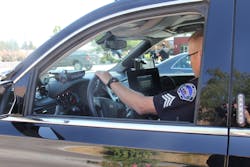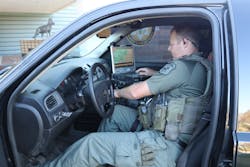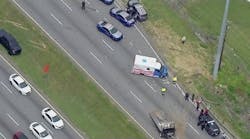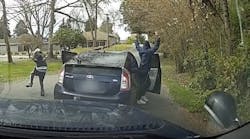In the mid-1990s a police officer was involved in the fast pursuit of an offender vehicle. The pursuit took him onto a state highway that was three lanes in each direction but went between residential communities. The speed limit was only 35 MPH. At one intersection the target vehicle went through a red light and the pursuing police vehicle, with all lights and siren activated, continued the chase.
An elderly woman driving a compact vehicle pulled out between the target vehicle and the pursuing police vehicle. The police vehicle hit her vehicle, almost “T-boned” her as the right side of the front end of the police vehicle hit her left front side. The police vehicle veered left after the impact, crossed the median and was hit by an on-coming vehicle traveling about 45 MPH in the right front side. That impact finished turning the police vehicle around so that it was now facing the opposite direction of the original pursuit and it came to rest against the far curb of the highway after hitting a light pole.
In the case of this particular accident there were five impacts just involving the law enforcement patrol vehicle (LEPV):
- The patrol vehicle into the civilian vehicle
- The second civilian vehicle
- impacting the patrol vehicle
- The patrol vehicle hitting the light pole/curbside
- The officer impacting the inside of his patrol vehicle
- The officer’s organs impacting the inside of him
Virtually every unanchored item inside a patrol vehicle becomes a potential projectile threat during a traffic accident and anything that juts out from the “normal” interior of a vehicle is something the officer can impact as he moves around inside the vehicle during and after an accident.
The vehicle in question in the incident above was a 1994 Ford Crown Victoria with the police pursuit package. It had been purchased by the municipality as a rider on the state police contract to keep costs as manageable as possible. Front driver and passenger airbags were all standard in the purchase contract package. Neither was disabled by the police department.
Inside of that particular patrol vehicle was all of the following equipment, none of which was included in any of the vehicle manufacturer’s safety design considerations:
- Center console with radio, light/siren switch box, outlet bank
- Prisoner transport cage/spit shield
- Seat organizer hanging on passenger seat (with ticket books, flashlight, etc.)
- MDT mount (although no MDT in it at the time of accident)
- “Wobble” light mounted to upper edge of windshield just right of rear view mirror
When the first impact occurred, some of the stuff stored in the seat organizer came out, as did the officer’s coffee mug that was in one of the two cup holders that was also mounted in the center console. The microphone for the radio came out of the clip.
At some point, the coffee cup hit the officer’s right arm just below the shoulder. The microphone hit the officer on the right side of his face just below the cheek bone. This likely occurred after the microphone bounced off the dashboard as it could only be released from the mounted clip going straight forward towards the engine. Blood and minor bits of skin tissue were in the microphone’s mounting nub and the cut under the officer’s cheek was curved and sized to match that nub. The officer’s ticket book, which had been in the seat organizer, ended up in the back seat, having gotten around the transport cage and spit shield in the small spaces next to the B-pillar. The officer was wearing his seatbelt and sometime in the course of the accident, the officer’s forehead struck the mount for the wobble light that was to the right of the rear view mirror.All of that happened inside what was thought to be a properly designed and safe patrol vehicle interior. That is an indicator of just how careful we need to be as we plan what equipment will go into our LEPVs. Often we don’t have a choice on “how much.” There is a mandate for equipment controls, certain supplies, MDTs, etc. Sometimes the best we can do is to ensure minimal intrusion into our “safety space” and that what we put in doesn’t impact the function of the manufacturer’s safety devices.
Best practices for today’s equipment installation planning include:
- Identify what vehicle your agency is getting
- Secure/procure the manufacturer’s safety diagrams that show all airbag deployments—and therefore the spaces you cannot allow equipment to intrude into
- Identify what minimum equipment must go into the vehicle
- Identify what other (optional) equipment “would be nice to have”
- Identify what mounting units you have to work with and ensure they comply with your space restrictions
- Diagram your installation placement and clearances, get sign off on that diagram and receive approval from the chain of command
With all of the other threats we face on the streets today, it’s imperative that we do all we can to protect ourselves inside of what should be a relatively safe space—the mobile office we call our patrol vehicle.




